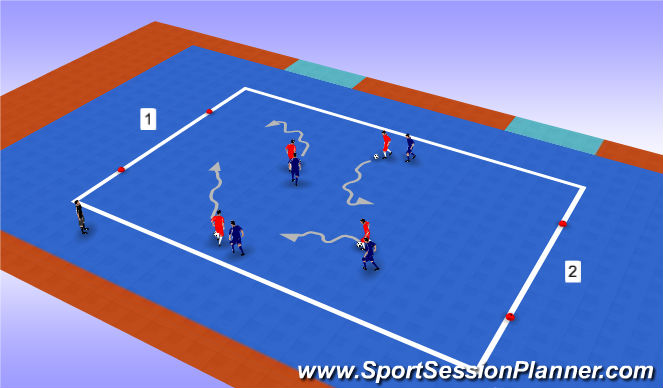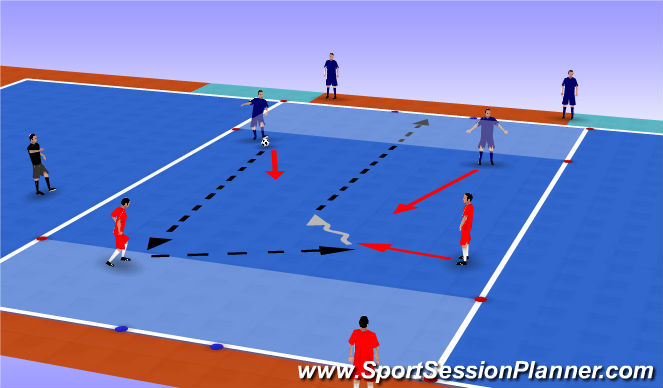Futsal Session (Senior): 1v1 Defensive Principles (Start Time: 10-Jun-2016 18:30h)
Profile Summary

| Name: | Cameron Gordon |
|---|---|
| City: | Canberra |
| Country: | Australia |
| Membership: | Adult Member |
| Sport: | Futsal |
Description
1v1 Defending Principles
To be successful in defence, players need to understand the both the Defensive System in place and the technical competencies of 1v1 defending. This session introduces the physical, psychological and tactical components of 1v1 defending, which set's the foundation for each defensive system, particularly the Man to Man marking system.
Coaching Points:
1. Body posture and movement;
2. Communication and covering the first defender;
3. Dominating the space of the attacker;
4. Identify when to recapture possession.

See the guidance at the top of this page to understand why you are not seeing interactive Futsal images.

Learning Objectives

|
Technical Dominating the space of the attacker. |

|
Physical Body posture and movement when defending. |

|
Psychological Decision making about when to recapture possession. |

See the guidance at the top of this page to understand why you are not seeing interactive Futsal images.

Learning Objectives

|
Technical Dominating the space of the attacker. |

|
Physical Body posture and movement when defending. |

|
Psychological Decision making about when to recapture possession. |
Functional (15 mins)
Set Up: Same drill set up as 'Basic' except only one ball is used in the middle of the grid.
Drill Coaching Points:
1. Body posture and movement;
2. Communication and covering the first defender;
3. Dominating the space of the attacker; and
4. Identify when to recapture possession.
Drill:
Step 1: Players move throughout the grid as they did in the basic drill except the attackers can pass the ball between them. Defenders are still passive.
Step 2: When the coach calls a number (1 or 2), the attacker with the ball attempts to dribble through the gate that was called. The defender who was marking the attacker with the ball tries to delay their progress.
Step 3: The remaining defenders must immediately cover their player who is marking the ball by dropping back behind the line of the ball. They may then join in defending the gate. The attackers without a ball must touch the nearest sideline and then they may join the attack.

See the guidance at the top of this page to understand why you are not seeing interactive Futsal images.

Learning Objectives

|
Technical Dominating the space of the attacker. |

|
Tactical Providing cover when using the man to man marking system. |

|
Physical Body posture and movement when defending. |

|
Psychological Decision making about when to recapture possession. |
Advanced (15 mins)
Set Up:
Dimensions: 20m x 10m grid
Equipment: 12 cones (some of which are placed along the sides of the grid, 5m from each end to signify '5m zones'), two small gates are set up at either end of the grid, at least one ball is required.
Players: 2 x attackers and 2 x defenders (or 3 attackers, vs 3 defenders)
Drill Coaching Points:
1. Body posture and movement;
2. Communication and covering the first defender;
3. Dominating the space of the attacker; and
4. Identify when to recapture possession.
Drill:
Step 1: One team starts with the ball (defenders). To signify the start of the drill, the defender with the ball plays a pass to the opposite team (attackers).
Step 2: The two attacking players try to progress from one end of grid to the other by either dribbling into the 5m zone at the end of the grid, or by passing the ball through the gate.
Condition: The pass through the gate must be below knee height no chips, scoops or lobs.
Note: The first defender should position themselves where they protect the pass to the gate in the first instance. They should then apply enough pressure (using good defensive posture and movement) to force the attacker away from the center of the grid, towards one of the edges.
Note: The second defender should always be goal side of their attacker while being deeper (behind the line) of the first defender. This allows them to provide cover in case the attacker beats first defender. The second defender must be ready to apply pressure if a pass is made to their attacker.
Note: When the defenders have dominated the space of the attackers and forced them into a vulnerable position, they should look to recapture possession of the ball.
Step 3: The drill is concluded when either the attack was successful, the defender wins possession or a time period (as definded by the coach) has been met (eg: 20 seconds).
Rotation: After the first drill ends, the teams swap roles and commence the drill again. Once the second drill ends both teams swap. After four drills, change the players within the teams and start again.

See the guidance at the top of this page to understand why you are not seeing interactive Futsal images.

Learning Objectives

|
Technical Dominating the space of the attacker. |

|
Tactical Providing cover when using the man to man marking system. |

|
Physical Body posture and movement when defending. |

|
Psychological Decision making about when to recapture possession. |
Game (15 mins)
Set Up: Full size court, 5v5.
Drill: Play a normal game.
Condition: Players must adopt the Man to Man (1v1) marking system.







 Play animation
Play animation Play step-by-step
Play step-by-step Repeat (toggle)
Repeat (toggle) Full Screen
Full Screen Pause
Pause Stop
Stop
Basic (15 mins)
Set Up:
Dimensions: 15m x 30m playing area.
Equipment: 4 cones are set up in 10m wide gates on each end of the grid, one ball between two players.
Players: Players work in pairs.
Drill Coaching Points:
1. Body posture and movement;
2. Dominating the space of the attacker; and
3. Identify when to recapture possession.
Drill:
Step 1: One player with the ball (attacker) dribbles around the grid while the player without a ball (defender) passively shadows their movements (not trying to recapture the ball).
The defender should use lateral movement to track their defender, avoid crossing their legs, keep a low centre of gravity by keeping their knees and hips bent, stay on their toes for agility and keep their hands up for balance.
Step 2: At any time, the coach yells out a number of one of the gates. The attacker must try to dribble through the gate that corresponds to the number that was called. The defender attempts to prevent the attacker from achieving this.
Ideally, the defender will:
- initially protect the goal, by getting themselves between the attacker and the target gate to delay the attackers progress;
- adopt good body posture and positioning and then dominate the space fo the attacker; and
- only attempt to win the ball back when safe to do so.
Step 3: The drill is concluded when either the attack was successful, the defender wins possession or a time period (as definded by the coach) has been reached (eg: 10 seconds).
Note: Players should be instructed that once a pair has finished their action (ball is won by defender, attacker was successful) they should remove themselves from the immediate vacinity of the target gate to avoid getting in the way of other participating players.
Rotation: After each coach call, the attacker and defender switch roles. After four calls, the players switch partners.